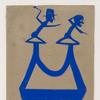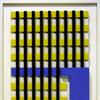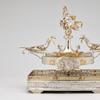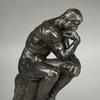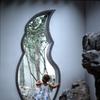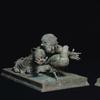Newly Discovered Works by Abbott Handerson Thayer in Williams College Museum's “Not Theories but Revelations”
- WILLIAMSTOWN, Massachusetts
- /
- March 06, 2016
“Not Theories but Revelations” opens March 11 at the Williams College Museum of Art (WCMA) and will be on view through August 21, 2016. Abbott Handerson Thayer, renowned twentieth century painter of ethereal angels, landscapes, and delicate flowers, was at the center of a raging debate around Darwin’s theories of evolution. As much a scientist as an artist, Thayer’s study of the visual world expressed itself in articles published in major scientific journals, an epistolary debate with Theodore Roosevelt, and in the development of the first prototype of military camouflage. “Not Theories but Revelations” is the first exhibition to address Thayer's artistic practice as part of his broader investigation of animal and human concealment. The exhibition includes many works that have never been seen in public, some of which remained sealed by Thayer until WCMA unpacked them.
In 1896 Thayer published the first of many articles on theories of animal concealment, which culminate in his book Concealing Coloration in the Animal Kingdom, published in 1909 and expanded in 1918. His theories came from the mingling of his art practice and his studies of nature. Thayer believed that his observation skills and knowledge of color theory as an artist were critical to his understanding of the principles of optics and the workings of natural selection. He had the revelation that animals' fur and feathers often broke the rules of good painting he was taught in the academies of Paris, noticing that many birds and small mammals are dark on their upper half and light on their lower, a phenomenon he called "counter shading." This color gradation effectively painted them out of their background, rendering them visually flat and invisible. He also came to see bold patterns and colors–including zebras and flamingos–as concealing. During WWI, Thayer transferred his work from animals to humans, developing camouflage patterns for ships and uniforms. Many of his concepts were deployed in the field and on the sea by French, American, and British militaries.
“Thayer is one of the most interesting but often overlooked artists of the early 20th century. He was wrestling with the big scientific and cultural questions of his era, and discussing–or arguing–about them with figures like Mark Twain and both presidents Roosevelt.” said Kevin Murphy, Eugénie Prendergast Curator of American Art at WCMA and curator of the exhibition. “We made some incredible discoveries while doing research for the exhibition that together with Thayer’s paintings of natural and supernatural subjects unify his seemingly eccentric artistic practice.”
"Not Theories but Revelations" is a 136 page full-color catalogue accompanying the exhibition. This book is the first significant publication on Thayer in more than a decade and the first to address his participation in some of the greatest scientific and cultural debates of his age. The book’s essay by Kevin Murphy contributes significant new scholarship on Thayer, while also exploring the divisive issues raised by his work and theories, including perception and optics, evolution, conservation, gender, philosophy, religion, and politics. The publication includes reproductions of work included in the exhibition, a comprehensive bibliography, and never before seen archival material.


